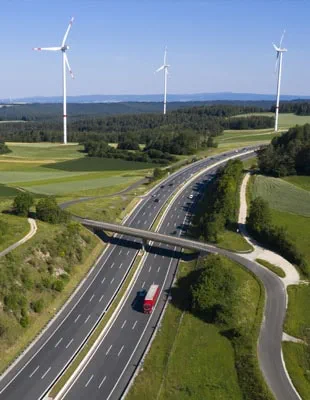The challenge
With the latest wind turbine prototype design in hand, a wind energy company needed a flexible project delivery partner to bring this complex project to life during a global pandemic.
With the latest wind turbine prototype design in hand, a wind energy company needed a flexible project delivery partner to bring this complex project to life during a global pandemic.
The organization tapped into our geotechnical expertise and flexible approach to lead the engineering, procurement and construction (EPC) of the infrastructure for the 3.0 megawatt series prototype wind turbine.
With a working prototype, the company can maximize design efficiency and assist the world’s transition to renewable energy.
Capturing the energy from wind is a powerful tool to realize our society’s energy transition goals. One wind turbine with a capacity of 1.67 megawatts (MW) at a 33% capacity factor can generate enough energy in 94 minutes to power a typical U.S. home for one month.
But before we can source energy from a field of wind turbines, it’s all about perfecting the prototype.
A wind energy company was ready to bring their latest wind turbine design to life. Needing an experienced engineering partner to design and construct the infrastructure required to build the prototype, the company selected Arcadis to lead the engineering, procurement and construction (EPC) of this latest project.
Wind turbines are enormous structures that can reach 165 meters in height with blades spanning longer than the length of an American football field. Preparing to build a wind turbine is no small feat – a challenge that demands creativity, collaboration and problem-solving skills. Our team of experts immediately set to work, planning and coordinating project logistics as the lead EPC firm on this wind turbine prototype.
The foundation was a critical component. It was imperative to design proper roads, turbine pads and crane pads to account for the heavy equipment loads and massive crane operations. Cranes needed to lift equipment that weighed as much as 100 tons, which demanded strong geotechnical expertise and civil design to ensure that wind turbine components were delivered securely and that the cranes performing the lifts had a stable operational foundation based on solid understanding of the soil mechanics.
Working during the COVID-19 pandemic added new layers of difficulty to the complex prototype build. Since the wind turbine was a prototype, the team did not have replacements for any broken or misplaced materials. Plus, the pandemic exacerbated the shortage of materials and laborers, so plans were thoroughly scrutinized at every step to maximize available resources.
In addition to providing technical expertise on permitting, civil design, electrical design, civil construction and construction management, we had to be flexible, responsive and timely in order to deliver the project under uniquely challenging conditions.

The wind turbine prototype will now operate under a two-year testing period to collect data and analyze the design while generating power for local communities. Once the study is complete, the wind turbine will be added to the organization’s collection of top-of-the-line wind turbines. Perfecting the designs with prototypes like these will help our client fulfill its mission to power our world for future generations with affordable, reliable and sustainable energy.
